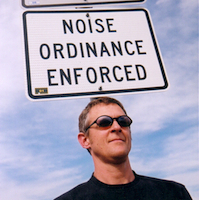 Mark Trayle is a California based musician and sound artist working in a variety of media including live electronic music, improvisation, installations, and compositions for chamber ensembles. Venues for performances and exhibitions have included Experimental Intermedia Foundation (NYC), Fylkingen (Stockholm), New Music America (Los Angeles and NYC), Ars Electronica, DEAF ’95 (Rotterdam), Sonambiente (Berlin), net_condition (ZKM Karlsruhe), Pro Musica Nova (Bremen), Resistance Fluctuations (Los Angeles), t-u-b-e (Munich), DEAF ‘04, Inventionen 2004 (Berlin), Format5 (Berlin), the San Francisco Electronic Music Festival, and clubs and galleries around the U.S. and Europe. His music has been performed by Champs D’Action, Ensemble Zwischentoene, Kammerensemble Neue Musik Berlin, and Ensemble Mosaik. Trayle’s many collaborators include Koji Asano, David Behrman, Nels Cline, Vinny Golia, Jason Kahn, Christian Kesten, Ulrich Krieger, Toshimaru Nakamura, Andrea Parkins, Wadada Leo Smith, the Rova Saxophone Quartet, and The Hub. He has recorded for the Artifact, Atavistic, CRI, Creative Sources, Inial, Los Angeles River, Elektra/Nonesuch, and Tzadik labels.
Mark Trayle is a California based musician and sound artist working in a variety of media including live electronic music, improvisation, installations, and compositions for chamber ensembles. Venues for performances and exhibitions have included Experimental Intermedia Foundation (NYC), Fylkingen (Stockholm), New Music America (Los Angeles and NYC), Ars Electronica, DEAF ’95 (Rotterdam), Sonambiente (Berlin), net_condition (ZKM Karlsruhe), Pro Musica Nova (Bremen), Resistance Fluctuations (Los Angeles), t-u-b-e (Munich), DEAF ‘04, Inventionen 2004 (Berlin), Format5 (Berlin), the San Francisco Electronic Music Festival, and clubs and galleries around the U.S. and Europe. His music has been performed by Champs D’Action, Ensemble Zwischentoene, Kammerensemble Neue Musik Berlin, and Ensemble Mosaik. Trayle’s many collaborators include Koji Asano, David Behrman, Nels Cline, Vinny Golia, Jason Kahn, Christian Kesten, Ulrich Krieger, Toshimaru Nakamura, Andrea Parkins, Wadada Leo Smith, the Rova Saxophone Quartet, and The Hub. He has recorded for the Artifact, Atavistic, CRI, Creative Sources, Inial, Los Angeles River, Elektra/Nonesuch, and Tzadik labels.
A consistent thread running through his music is the idea of emergence. Perhaps more accurately, the sound of emergence. The late 70s found him interconnecting analog synth modules, enjoying the sounds of the wildlife in a seemingly random electronic ecosystem, waiting for patterns to emerge. Since the early days of ‘personal computing’ he has done the same in the digital domain. His recent work has focused on extending that sonic exploration with resonant objects and spaces, in pieces made from electronic feedback networks both analog and digital. To Mark, these are processes of listening, discovery, and adaptation rather than musical determinacy.
His installation for SoundWalk 2011, with the working title golden zephyrs, plays with both material and acoustic phenomena. In the 17th century the English physicist Robert Hooke discovered that particles on a vibrating surface will form nodal patterns related to the frequency of sound propagating through that surface. Similarly, closely tuned high frequency sound waves will create patterns in an acoustic space. In golden zephyrs gold glitter is periodically deposited on a small piezoelectric disc. Ultrasonic square waves play through the disc causing the glitter to form patterns that emerge, change, and disappear. Sometimes the glitter flies off the disc. The ultrasound waves (and their lower frequency auxiliary tones) also create patterns of varying amplitudes and frequencies in the acoustic space.
Shortly after he finished a prototype for the piece he realized that it reminded him of a Tibetan Buddhist offering practice. Gold, gemstones, and other precious materials are placed on a golden plate in the form of a mandala, then offered to one’s guru and other teachers past and present. Mark would like you to consider this an offering for your eyes and ears.
photo credit: Tom Leeser